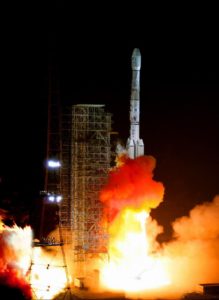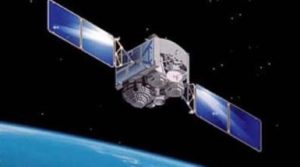The recent announcement by China to orbit ten Earth observation satellites to solidify its sovereign claim for the South China Sea is a harbinger of the competitions to come for the control of other vital strategic waters across the globe. ThorGroup’s Chairman and President, Dr. John B. Sheldon, examines this phenomenon and why it matters.

China’s controversial claim of over ninety percent of the South China Sea is not something they are pursuing using just diplomatic and legalistic tools bilaterally and through a variety of international forums. Beijing’s claims are also being made through actions ranging from the establishment of bases on disputed islands, and even artificially made islands, despite protests from other countries with claims in the South China Sea such as Vietnam and the Philippines, through to a concerted effort to establish dominance across the claimed seas using aggressive naval patrols, manned and unmanned aerial reconnaissance, undersea surveillance, and more recently, its announced plans for continuous and persistent space-based maritime domain awareness (MDA).
The plan, announced in early January, involves launching ten satellites into low-Earth orbit from a launch site on Hainan, the Chinese island at the northern end of the South China Sea. Using six electro-optical, two hyperspectral, and two synthetic aperture radar (SAR) imaging satellites to be launched between 2019 and 2021, the Chinese government aims to solidify its claims over the South China Sea, and eventually – effectively by fait accompli through a mixture of naval, military, and space dominance along with legal and diplomatic offensives – nullify all other competing claims from neighbouring countries to include the Sultanate of Brunei, Indonesia, Malaysia, the Philippines, and Vietnam.
These satellites will be able to provide the Chinese with a persistent presence over the South China Sea that not only allows them to monitor fishery and energy resources there. They also provide an extended strategic depth that allows Chinese authorities to identify potential threats to their sovereign claims and efficiently allocate terrestrial capabilities – such as aerial and naval assets – to deal with them as early as possible.
This gets to the heart of the relationship between satellites and sea control, and it is a relationship that will increasingly feature in maritime affairs in the 21st century.
At stake are considerable resources in an area covering approximately 3.5 million kilometres and possessing significant energy and fishery resources of immense economic value. On top of this, major sea lines of communications (SLOCS) between the Straits of Malacca and South Korea and Japan all cut through the South China Sea. China’s claims, based on what Beijing views as legitimate historical antecedents, could not only threaten access to the South China Sea and its resources by its neighbours and, theoretically, by those seeking peaceful navigation along the SLOCS that go through it, but also threatens to bring about the end of the norms and legal customs that underpin current maritime law, as enshrined in the United Nation’s Convention on the Law of the Sea (UNCLOS).
The Relationship Between Spacepower and Sea Control
Spacepower is the ability to exert prompt influence to, in, and from space in peace, crisis, and war using military, civil, and commercial space assets. In the context of the South China Sea, China has spacepower in abundance because of its ever expanding space industrial base, highly developed space launch capability, several launch sites, a manned space programme, and an increasingly sophisticated background in satellite design, manufacture, operations, and applications across the whole range of satellite functions in communications, Earth observation, positioning, navigation, and timing (PNT), intelligence gathering, and environmental monitoring. It is this spacepower, along with China’s expanding naval and military capabilities, that is being brought to bear in the South China Sea. These combined space, sea, and aerial capabilities are allowing China to exert sea control throughout the South China Sea against all competing claimants and those, such as the United States, who seek to exert the right of Freedom of Navigation through those waters.
Spacepower confers a number of strategic advantages to those who possess it. The overall strategic advantage of spacepower is the sum of its four interrelated and unique strategic features, namely:
Perspective: satellites operate at altitudes in Earth orbit that allow them to cover and sense large swaths of the Earth’s surface that provide a perspective that no other strategic domain – including the air – cannot provide;
Persistence and Presence: this perspective leads in turn to the strategic advantage of persistence and presence. Sufficient number of satellites in various orbits and orbital planes provides persistence and a presence, both regional and global;
Access: in turn, perspective, persistence, and presence create the strategic advantage of access to physically remote and closed off parts of the globe. This strategic advantage is helped by an international legal regime based on the 1967 Outer Space Treaty that renders space conceptually immune from sovereign and territorial claims (though this concept, while generally observed, has yet to be tested in extremis);
Strategic Depth: lastly, the strategic advantages of perspective, persistence and presence, and access, all combine to create the strategic advantage of strategic depth. Spacepower can expand the strategic depth of those who possess it, providing greater strategic early warning and the more efficient allocation of naval, military, and other national capabilities in a state’s implementation of its foreign and security policies.
This strategic advantage of spacepower, however, is only as good as the ability to act upon it terrestrially. In order to exploit the strategic depth that spacepower confers, a state requires sufficient terrestrial-based capabilities such as ships and airplanes, as well as the requisite command and control and logistical arrangements. The difference that spacepower brings to its user is that it can defray the numbers, and therefore costs, of these terrestrial capabilities because it enables their more efficient use. In other words, a state’s spacepower is only as good as its ability to act on the change detection and connectivity made by satellites through its land-, sea-, air-, and cyber power.
Ultimately, this is why China’s neighbours such as Vietnam and the Philippines cannot compete, despite the development of their own space programmes. These countries, unless they truly combine all of their assets and coordinate their policies in countering Chinese claims in the South China Sea, cannot compete because they are unable to press the advantage that their own spacepower could provide them. Hanoi and Manila may be able to observe Chinese activities in the South China Sea, but they are – by and large – unable to do anything about it because of insufficient naval and aerial assets, and the ability to sustain those assets, to press and defend their own sovereign claims.
Spacepower and Sea Control Beyond the South China Sea

The example of the South China Sea offers some lessons for the contested control of other strategic waters around the world, though there are, of course, key differences in political and diplomatic contexts.
Russia, especially, is using spacepower to solidify its control of the Black and Caspian Seas, where the combination of Russian space-, sea, and air power have created what maritime strategists refer to as bastions from which Moscow can project power.
In the Eastern Mediterranean, Russia, with its presence in Syria, Turkey, Israel, and increasingly, Egypt, are all using spacepower to help each country deny the others dominance. The Eastern Mediterranean is not only a vital strategic location because it is where the Suez Canal connects with the Mediterranean Sea, but it is also where Russian sea power connects with the Black Sea and is also the location of significant energy resources.
Contested control is also found in the Western Mediterranean, where France, Italy, Spain, Morocco, and Algeria have, or are acquiring, spacepower to monitor the Straits of Gibralter chokepoint, and provide intelligence on migrant flows across the Mediterranean from North Africa to Southern Europe.
In the Persian Gulf, Red Sea, and the Suez Canal, aggressive Iranian naval activity and ambitions, as well as the ongoing war in Yemen along the northern coast of the Red Sea, is bring spacepower to the fore among the main actors with strategic interests in these areas. Egypt, Ethiopia, Israel, Oman, Saudi Arabia, and the United Arab Emirates are all using spacepower, or acquiring it, in order to be able compete for influence and control of these key strategic waters and trade routes.
Lastly, and perhaps more significantly, the Indian Ocean will likely be the scene for significant spacepower competition between China, India, United States, and other states, as they vie for dominance over what is becoming perhaps the most strategically significant ocean in the 21st century. This importance is not only the result of Indian and Chinese strategic competition in general, but also because the Indian Ocean is key to the grand strategic ambitions of both countries, such as the maritime trade element of Beijing’s Belt and Road Initiative (BRI), and New Delhi’s Look East and West diplomatic initiatives.
Conclusion
As spacepower becomes critical for the exercise of sea control in key strategic locations and maritime strategies in general, a number of issues arise for policy makers and corporate executives in the satellite, transportation, and energy sectors.
First, the relationship between spacepower and sea control exposes the limits of transparency. Many international relations experts have exalted the salience of the transparency that spacepower brings to international politics, but all too often forget the difference between knowing something is happening and the ability to do something about it. Balanced capabilities, and the ability to sustain those capabilities, across all strategic domains still matters.
Second, the growing relationship between spacepower and sea power will only make the possibility of space warfare more likely in the coming decades. Strategists and military planners will find that the ability to deny a rival’s ability to exert control over a strategic maritime location by impairing its spacepower advantage. This emerging strategic reality will test efforts to prevent the possibility of conflict in space.
Spacepower is a necessary, but not sufficient, ingredient for contemporary sea control. Understanding that relationship now, and creating opportunities to defuse strategic competition before they become too dangerous, is a task that all those interested in maintaining peace and stability should take seriously.
Dr. John B. Sheldon is the Chairman and President of ThorGroup GmbH, and publisher of SpaceWatch.Global.


